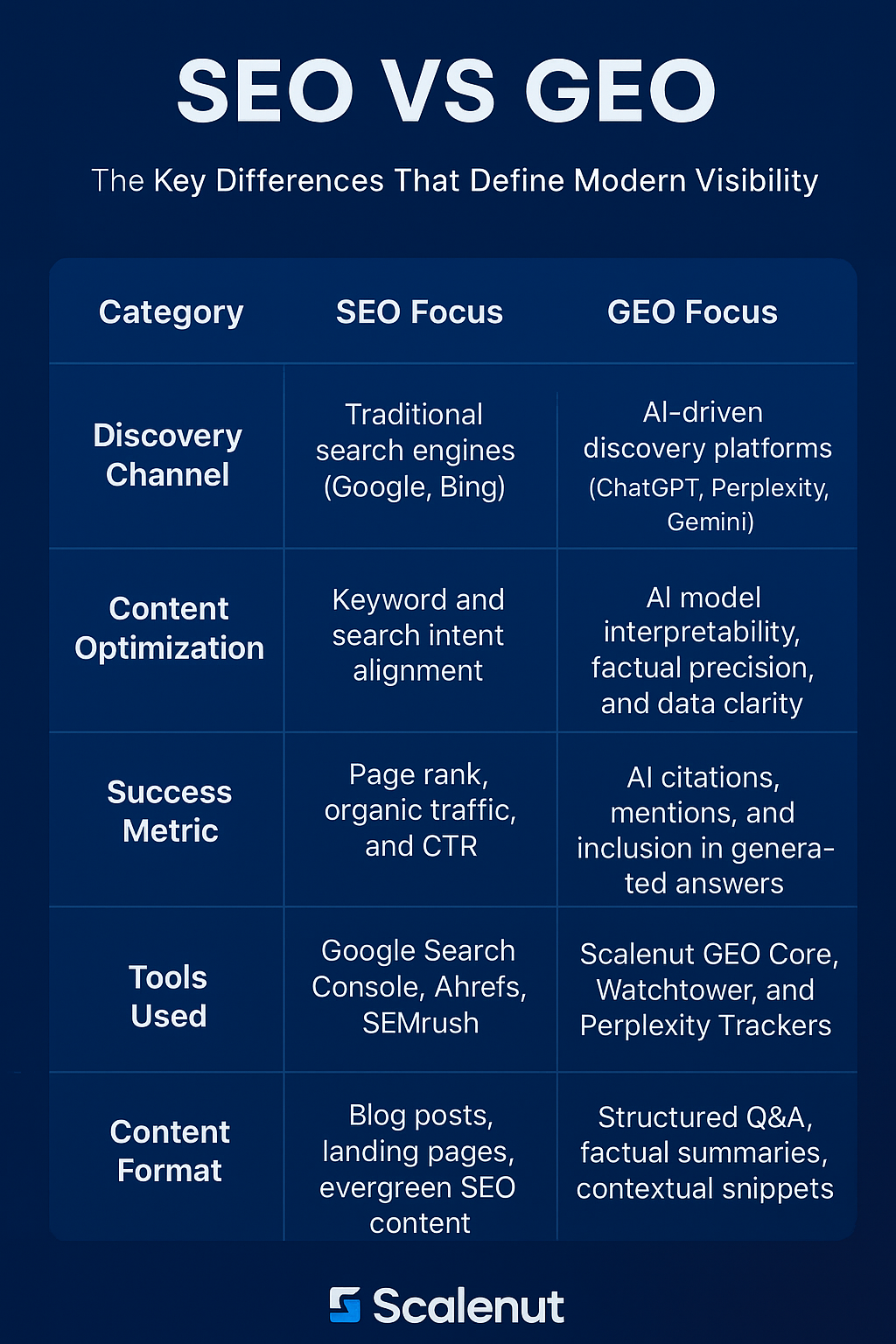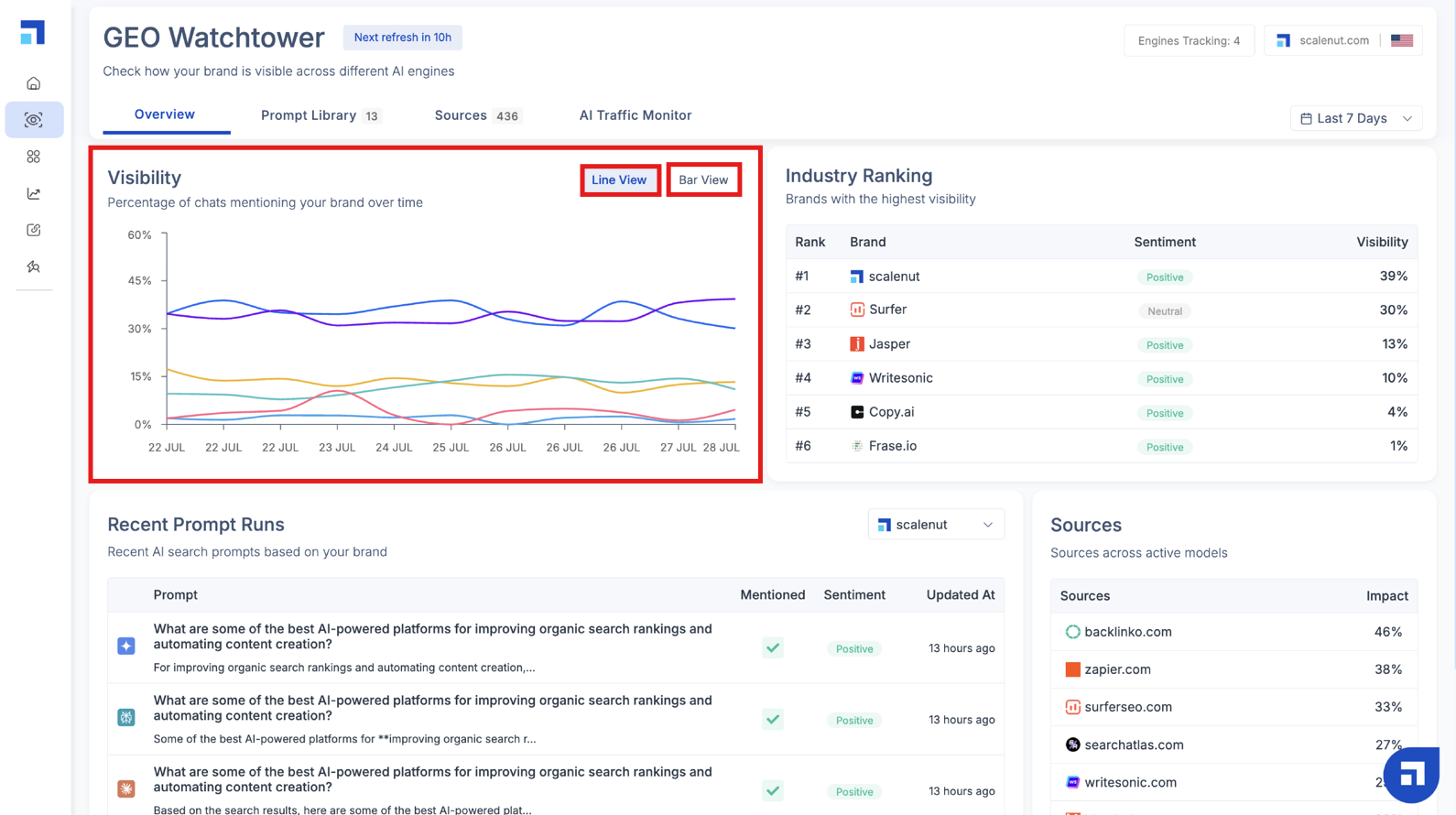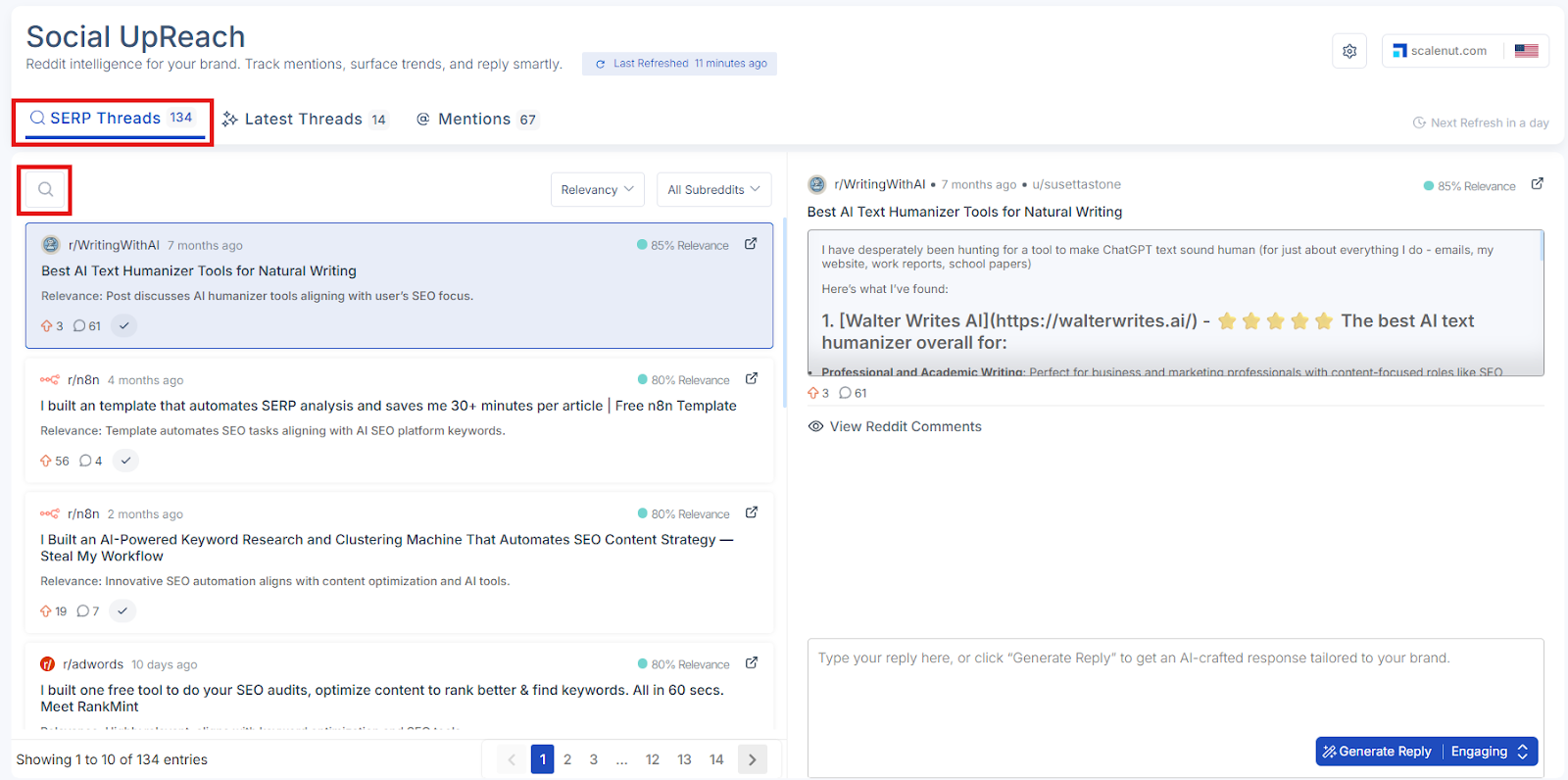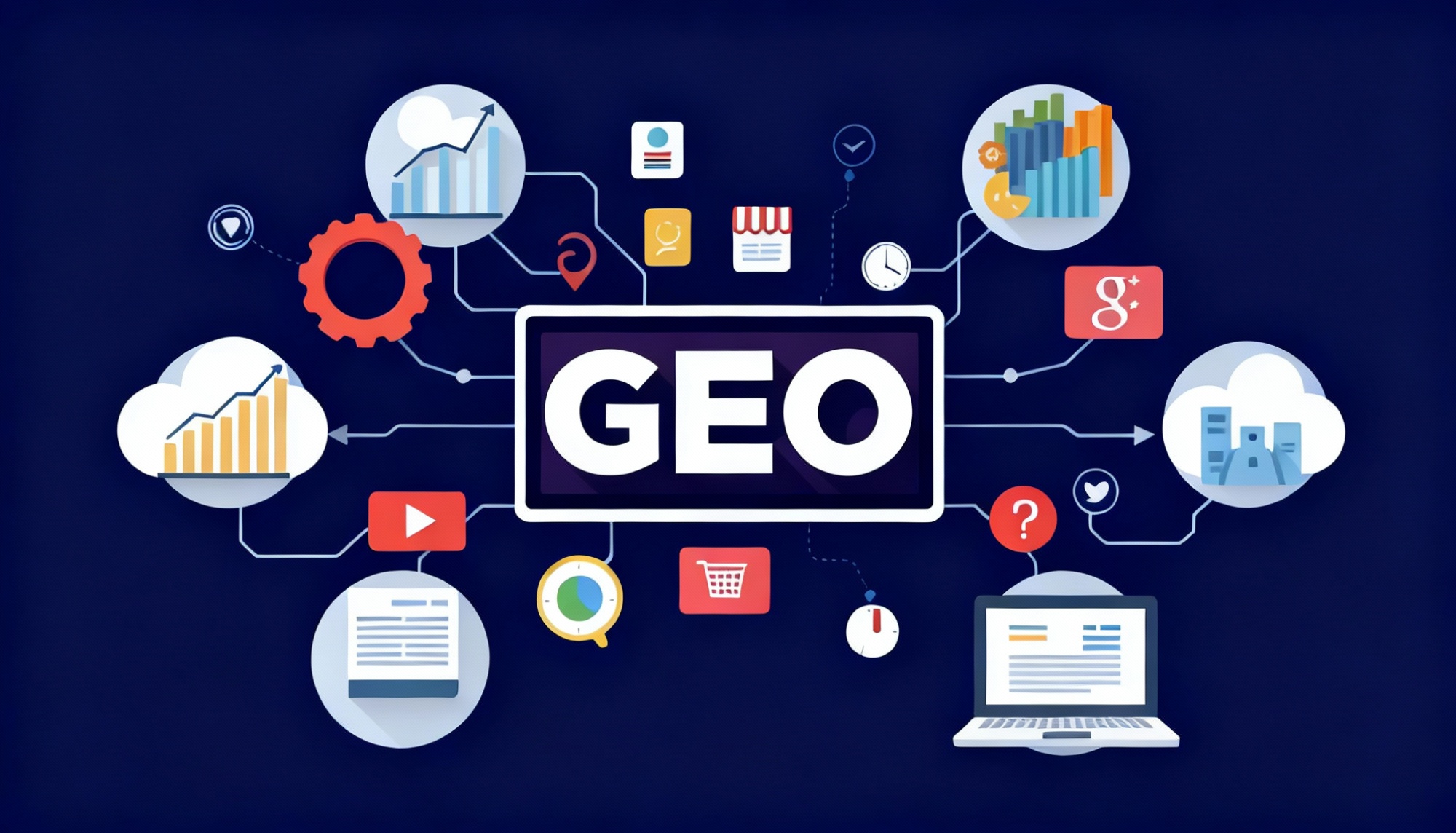Key Highlights
- Generative engine optimization (GEO) is the new frontier, optimizing content for AI-driven search engines.
- Unlike traditional SEO, your geo seo strategy focuses on context, user intent, and getting cited in AI answers.
- Adopting GEO is crucial for maintaining search visibility as user behavior shifts to AI platforms.
- A strong GEO plan builds on SEO principles like E-E-A-T but requires new content structures.
- Mastering generative engine optimization now will future-proof your online presence against competitors.
- Properly implemented, this seo strategy improves your visibility on AI search engines.
What is GEO, and how is it different from traditional SEO?
GEO (Generative Engine Optimization) is the process of optimizing content to appear in AI-generated answers, summaries, and conversational search results across tools like ChatGPT, Google AI Overviews, and Perplexity, playing a vital role in the AI-driven future of search. It focuses on how generative models interpret, cite, and present brand information.
Unlike traditional SEO, which targets rankings on search engine result pages (SERPs), GEO aims to make your content discoverable and quotable by AI systems, including aspects of link building. It emphasizes structured data, clear factual writing, and authoritative sources so that AI models identify your brand as a trusted reference when generating responses.
GEO vs SEO: What are the key similarities and differences?
While Geo SEO represents a new direction, it shares common ground with traditional search engine optimization, both of which aim to boost your website’s visibility online.
Key Similarities
- Both aim to increase content visibility and authority online.
- Both rely on quality, relevance, and credibility of information.
- Both benefit from structured data, internal linking, and topic depth.
Key Differences

Why Are Businesses Shifting From SEO to GEO in the Age of AI Search Engines?
Businesses are shifting from SEO to GEO (Generative Engine Optimization) because search behavior is undergoing a fundamental change. Traditional SEO focuses on ranking on Google’s results page, but users are increasingly turning to AI-driven platforms like ChatGPT, Perplexity, and the Google Search Generative Experience (SGE), which deliver answers directly, often without requiring a single click on search results.
Here's a clear example: Imagine a SaaS company that ranks #1 on Google for “best project management software.” That used to guarantee visibility. However, if ChatGPT or Perplexity cites a competitor’s product guide in its response instead, the competitor becomes the trusted source, even if they’re ranked lower in traditional search.
GEO flips the focus from ranking to being referenced. It’s about structuring content so AI systems understand, trust, and cite it.
By optimizing for how large language models interpret and deliver answers, businesses ensure they remain visible and authoritative in the spaces where users now make decisions, directly within the results of generative AI.
What is the importance of GEO SEO in Modern Digital Marketing?
In the era of AI-driven search, relying solely on traditional SEO is no longer enough. Platforms like ChatGPT, Bing AI, Perplexity, and Google AI Overviews are changing how users discover information, delivering direct, conversational answers from these innovative 'answer engines' instead of just lists of links.
To stay visible and competitive, brands need GEO (Generative Engine Optimization) to ensure their content is not just ranked but referenced and trusted within these AI responses.
How GEO SEO Boosts Visibility in AI-Powered Search?
GEO SEO positions your content to appear where users now look first: inside AI-generated answers. Instead of only chasing a top search result, GEO ensures your brand becomes part of the actual response users see. When your content is structured and authoritative, GEO plays a crucial role in successful marketing campaigns, allowing AI systems to parse and trust it, weaving your data, quotes, and insights into the answers they deliver.
This shift doesn’t just improve visibility; it enhances engagement and conversion quality. Users arriving via AI-generated responses are often deeper in the decision-making process, leading to higher-intent interactions and better business outcomes, even if traditional traffic numbers remain stable or decrease.
Example: A law firm might rank well for “how to file a trademark,” but if ChatGPT cites a competitor’s detailed guide instead, that competitor gains authority and leads. GEO fixes this by structuring the firm’s content for AI comprehension and citation.
The Role of Generative Engines in GEO SEO
Generative engines like ChatGPT don’t simply index content; they synthesize it from multiple sources into conversational answers. GEO ensures your content is chosen in that synthesis process by focusing on clarity, structure, and authority in responding to search queries. Well-structured information with clear answers signals reliability, making it more likely that your brand will be cited directly in AI outputs.
Enhancing Local and Conversational Search
GEO SEO is especially effective for conversational and local search, where queries are more natural and detailed. Instead of just targeting short keywords like “plumber in Brooklyn,” generative search engines help you rank for real questions like “Who is the most reliable emergency plumber in Brooklyn?” , precisely the type of query AI tools process best.
For local businesses, this structured and authoritative approach enables AI platforms to more easily verify and recommend them in search responses, thereby significantly boosting visibility and trust.
Beginner’s Guide: Getting Started With GEO SEO
Ready to dive into Geo SEO but not sure where to begin? Getting started is more straightforward than you might think. It begins with equipping yourself with the right knowledge, tools, and a clear plan. Your existing marketing strategy can serve as a great launchpad for this new venture.
This section will walk you through the essentials. We'll cover the must-have seo tools and resources, the data platforms you'll need to track your success, and how to prepare a content strategy designed for the age of AI.
Essential Tools and Resources for Geo SEO
To effectively implement your local SEO optimization strategies, having the right set of tools is essential. These resources can help you with everything from keyword research to analyzing AI-generated content. Many traditional SEO tools are still highly valuable, but new, specialized tools are also emerging to address the unique needs of GEO.
For keyword research, platforms like Semrush and Ahrefs are excellent for identifying long-tail queries and understanding user intent. They can help you find the conversational phrases your audience is using. In addition, specialized tools are being developed to analyze your visibility in AI search, giving you crucial data points on performance.
Here are some essential tools and resources to add to your arsenal:
- Keyword Research Tools: Use platforms like LowFruits or Google Keyword Planner to find conversational, low-competition keywords.
- AI Search Graders: Tools like HubSpot’s AI Search Grader can show you your brand's current visibility and presence in AI-generated answers.
- SEO Plugins: WordPress plugins like All in One SEO (AIOSEO) offer features to add schema markup and build topical authority, which are critical for GEO.
- Community Forums: Stay updated by joining discussions on industry blogs and forums where practitioners share the latest trends.
Must-Have Data and Analytics Platforms
To know if your Geo SEO efforts are paying off, you need to track your performance with the right data and analytics platforms. Monitoring key metrics is the only way to make data-driven decisions and refine your strategy over time. While some traditional metrics are still relevant, GEO requires you to look at new data points.
Google Search Console (GSC) remains a fundamental tool. It provides invaluable information on how your site performs in search engine results, including impressions, clicks, and average position for specific queries. Many SEO plugins now integrate directly with GSC, bringing this data into your website’s dashboard for easier access.
For a deeper analysis of your online presence, look for platforms that can track referral traffic from AI engines and monitor your brand mentions within AI-generated responses. Tracking these metrics will give you a clear picture of your website traffic and how users are discovering you through AI. This allows you to measure the direct impact of your GEO strategy.
Preparing a Content Strategy for Geo SEO Success
A successful digital marketing strategy for Geo SEO begins with a well-prepared SEO content strategy. Your goal is to create relevant content that is not only valuable to human readers but also structured for AI to easily understand and cite. This means focusing on comprehensiveness, authority, and clarity.
Your content creation process should start with identifying topics where you can provide in-depth, expert answers. Move beyond surface-level articles and create comprehensive resources that fully address a user's potential questions on a subject. This establishes your site as an authoritative source, especially when you link to reputable sources, a key factor for AI engines.
Structure is just as important as substance. Organize your content with clear headings, use bullet points, and provide direct answers to likely user questions. This improves user engagement and makes your content more 'parsable' for AI. By aligning your content strategy with these principles, you'll be well-positioned for success in the AI-driven search landscape.
How to implement SEO GEO Strategies?
Understanding GEO is one thing; applying it is where the real results happen.
A successful Generative Engine Optimization strategy isn’t about one quick fix. It’s an ongoing process of aligning your content with how AI platforms understand, surface, and cite information. Here’s how to put it into action:
Step 1: Conduct GEO-Focused Keyword Research
Traditional keyword research focuses on short phrases. GEO demands question-based, conversational queries, similar to those used by people who utilize ChatGPT or Google’s AI Overviews.
- Start by mapping out questions users are asking around your topic.
- Analyze AI-generated answers to understand how queries are structured.
- Focus on long-tail, intent-rich phrases that reveal what users truly want.
Example: Instead of just “best CRM software,” target “What’s the best CRM software for remote teams in 2025?”, a query far more likely to trigger an AI Overview.
Step 2: Structure and Optimize Content for AI Engines
AI models need clarity. Structure your content so it’s easy to parse, extract, and cite.
- Use clear headings (H1, H2, H3) to guide AI through your content.
- Write short paragraphs, direct answers, and use bullet points for key data.
- Add FAQ sections that answer conversational questions directly.
Think of your content as something an LLM could quote verbatim. If it’s easy for a human to scan, it’s easier for AI to understand.
Step 3: Strengthen Technical SEO for AI Compatibility
Your site must be easy for AI crawlers to read and trust. Key priorities:
- Fast page load times, mobile optimization, and HTTPS security.
- Use schema markup to add structured data and context to your content.
- Perform regular technical audits to ensure search engines can crawl efficiently.
Structured data is especially powerful here, it helps generative engines know exactly what your content is and how to use it.
Step 4: Add Multimedia and Localized Context
AI engines process more than text. Supporting assets can improve visibility and engagement.
- Use infographics and visuals to make complex data easy to understand.
- Embed explainer videos to improve time on page and signal depth.
- Include localized content (like maps or region-specific terms) to boost relevance in local searches.
Example: A blog post titled “How to Choose a Plumber” could become “How to Find a Reliable Plumber in Brooklyn, with a Checklist Video” , making it more useful and discoverable to AI.
Step 5: Build Authority Through Backlinks and Brand Consistency
Generative engines pull from sources they trust. Building that trust means proving your authority.
- Earn high-quality backlinks from credible sites.
- Publish original research, case studies, or data-rich reports.
- Keep brand data consistent across all platforms and listings.
Positive reviews, citations, and mentions strengthen your brand’s reliability, increasing your chances of being referenced in AI-generated responses.
Step 6: Monitor, Measure, and Iterate
GEO isn’t static. Track how your content is cited in AI Overviews and conversational platforms, then adapt.
- Monitor referral traffic from AI engines.
- Track how often your brand is mentioned or cited in generated answers.
- Continuously refine content to match evolving user intent and AI behavior.
Tools like Scalenut’s GEO Watchtower can help you see where you’re visible, and where you’re not.
What are the common challenges in GEO SEO and how to solve them?
Shifting from traditional SEO to Generative Engine Optimization (GEO) is a significant leap, and, like any major shift, it comes with its own set of obstacles. The rise of artificial intelligence (AI) in search is evolving rapidly, and many brands stumble because they attempt to apply outdated SEO habits to a new system that operates by different rules. The good news? Every challenge has a straightforward solution, if you know where to look.
Here's how to navigate the most common GEO SEO roadblocks and stay ahead of the curve.
1. Tackling Technical Barriers That Limit AI Visibility
The challenge: Even the best content won’t surface in AI-generated answers if your website isn’t technically optimized. Slow load times, messy site architecture, broken schema, or poor mobile experience can all make it more complicated for generative engines to crawl, understand, and cite your content.
The solution:
- Run regular technical SEO audits to identify and resolve crawlability, indexing, and performance issues before they impact visibility.
- Implement structured data (schema markup) to give AI platforms explicit context about your pages.
- Optimize for mobile-first performance and site speed, both of which are ranking signals for AI-driven search.
Example: A B2B SaaS company saw its content cited 3 times more in Google’s AI Overviews after fixing schema markup errors and reducing load time from 5 seconds to under 2 seconds, with no new content needed.
2. Staying Ahead of Rapidly Evolving AI Search Algorithms
The challenge: GEO is a moving target. AI algorithms evolve faster than traditional search, and strategies that work today might lose effectiveness next quarter. Brands that don’t adapt quickly risk losing visibility.
The solution:
- Monitor how AI Overviews and LLM answers evolve for your target keywords, watch shifts in structure, tone, and cited sources.
- Anchor your content strategy in evergreen principles: clarity, authority, trust, and user intent. These remain stable even as algorithms shift.
- Stay informed about industry updates, research papers, and platform announcements to anticipate changes before they impact your performance.
Example: Brands that quickly adapted to Perplexity's preference for “fact-first” formatting saw a 40% increase in citations, while those relying on generic blog-style content saw visibility drop.
3. Avoiding Strategic Missteps When Moving from SEO to GEO
The challenge: The biggest mistakes happen when teams treat GEO like traditional SEO. Keyword stuffing, thin content, or ignoring user intent in user queries might have slipped by in the past, but generative engines penalize them now. Another common misstep: optimizing for only one platform instead of building a multi-engine presence.
The solution:
- Think beyond keywords. Prioritize intent, depth, and clarity. Each piece should answer a real question comprehensively.
- Show E-E-A-T (Experience, Expertise, Authoritativeness, Trustworthiness) throughout your content, with original data, expert quotes, and credible sources citations.
- Design for AI parsing. Utilize a strong content structure, headings, FAQs, and schema so models can easily extract and utilize your information.
- Diversify. Optimize not just for Google AI Overviews but also for ChatGPT, Perplexity, Gemini, and Bing Copilot.
Example: A fintech startup saw no results for months because its content was keyword-heavy and lacked authority. After shifting to a question-based, E-E-A-T-rich content model, it started appearing in Gemini’s AI snippets and ChatGPT answers within six weeks.
How can Scalenut contribute to your GEO SEO Success?
Scalenut is more than just another SEO tool, it’s a complete GEO SEO platform built for the era of AI search. It helps brands go beyond traditional rankings and get cited, referenced, and recommended inside AI Overviews, ChatGPT, Perplexity, Bing Copilot, and other generative search platforms.
What sets Scalenut apart is how seamlessly it connects every part of the GEO process, from tracking your current AI visibility to building content that’s optimized for answer engines.
Its GEO Watchtower shows exactly where and how your brand appears in AI results, while GEO Core and Cruise Mode turn those insights into high-performing, AI-ready content. Paired with tools like Content Audit, Social UpReach, and Backlinks Marketplace, Scalenut helps you close visibility gaps, build authority, and stay relevant as search evolves.
Whether you’re managing one brand or scaling multiple, Scalenut’s intuitive workflows and real-time insights make adapting your strategy for AI discovery far easier and faster. without the guesswork.
Here's a complete breakdown of the GEO features in Scalenut -
Step 1: Know Where You Stand with GEO Watchtower
Everything starts with visibility. GEO Watchtower helps you monitor exactly where your brand appears across AI engines. It identifies which of your pages are being cited, which topics you’re missing, and where competitors are leading.
This gives you a data-backed map of your AI presence, the foundation for deciding what to create or optimize next.
Example: If a competitor is cited in Perplexity for “best enterprise CRM software” and you’re not, you instantly know where to focus your next content push.

Step 2: Plan and Create with GEO Core and Cruise Mode
Once you know your visibility gaps, GEO Core takes over. Your central suite for Answer Engine Optimization (AEO) and GEO-aligned content creation. It integrates research, keyword intelligence, and AI optimization so your content ranks not just in Google, but also in conversational AI results.
With Cruise Mode, Scalenut simplifies content creation from start to finish. It helps you uncover intent-rich topics, structure your articles for readability and AI parsing, and produce polished, human-quality drafts, all guided by data.

Step 3: Refine and Align with Content Audit
After publishing, Content Audit ensures your site stays optimized. It evaluates existing pages for both traditional SEO performance and AI-readiness, identifying what’s performing, what needs updates, and where intent alignment can improve.
This continuous feedback loop ensures your content ecosystem evolves with how AI models understand and surface information.

Step 4: Amplify Your Reach with Social UpReach.
Visibility doesn’t stop at content creation.
Social UpReach helps you stay active where AI learns, especially on Reddit, a key platform feeding AI models. It tracks brand mentions, community discussions, and emerging trends, letting you shape your brand narrative early.

Step 5: Build Authority with Backlinks Marketplace
To strengthen authority, the Backlinks Marketplace offers a faster path to credible citations by connecting you with vetted publishers and blogs. This boosts your domain trust and increases your likelihood of being cited by AI systems. Forget cold outreach.
Scalenut’s Backlinks Marketplace acts like a curated store of vetted sites and blogs ready to feature your links. This shortens the path to building domain authority, which in turn boosts your AI search visibility.

Scalenut connects every stage into one cohesive workflow. You gain real-time visibility data, actionable content insights, and tools to build authority, all within a single ecosystem designed for the future of AI search.
Try Scalenut today and see how your brand performs across AI search engines, uncovering new opportunities to boost your presence.
Conclusion
Mastering GEO and SEO strategies is no longer optional. It’s essential for brands that want to maintain visibility across both search engines and AI-driven platforms. When focusing on user intent, structured content, and AI-readability, you can build a content ecosystem that resonates with both humans and generative models.
Implementing these strategies not only strengthens your search performance but also enhances brand authority and trust across emerging AI discovery channels.
With Scalenut, you can simplify this process. Its GEO Suite empowers you to track brand mentions in AI engines, uncover visibility gaps, and optimize content for both traditional SEO and next-gen AI search. As the digital landscape evolves, Scalenut helps your business stay ahead, visible, relevant, and trusted everywhere your audience is searching.
Frequently Asked Questions
Is SEO really being replaced by GEO, or should businesses use both?
GEO isn't replacing SEO; instead, it extends it. Think of your SEO strategy as a foundation and Geo SEO as the next level of search engine optimization. Businesses should leverage both traditional search engines and social media to create a robust digital marketing plan that maximizes visibility across conventional search engines and new AI search engines.
What tools can help optimize for GEO in AI search engines?
Several seo tools can help with Geo SEO. Platforms like Semrush are great for keyword research, while specialized tools like HubSpot's AI Search Grader analyze your visibility on AI search engines. WordPress plugins, such as AIOSEO, can also assist with technical optimization strategies, like implementing schema markup.
How do I measure the success of my Geo SEO strategy?
Measure your Geo SEO success by tracking new data points alongside traditional metrics, such as organic traffic. Use analytics platforms to monitor referral website traffic from AI engines, the frequency of your brand's citations in AI answers, and the conversion quality of users arriving from these sources.
Can GEO improve performance on platforms like ChatGPT?
Yes, absolutely. Geo SEO is designed to improve performance on generative engines like ChatGPT by focusing on natural language queries. Through strategic content optimization, GEO increases the likelihood that your content will be used as a source in AI-generated answers, boosting your credibility and enhancing user engagement on these conversational platforms.
How is traditional SEO different from GEO?
Unlike traditional seo, your GEO SEO strategy focuses on context, user intent, and getting cited in AI answers. Leading brands have found success with GEO strategies such as publishing expert-level, deeply contextual content that directly answers questions or incorporates FAQ formats, making their content more likely to be cited by AI search engines.
How often are tools like ChatGPT, Perplexity, or Gemini mentioning your brand?
To track how often platforms like ChatGPT, Perplexity, or Gemini mention your brand, set up Google Alerts for your brand and keywords. Utilize social listening tools to track mentions and sentiment on AI platforms. SEO analytics can show how often your URLs appear in generative content. Regularly review these insights to understand your brand’s presence in AI search engines.
Is SEO dead? What do you know about GEO?
SEO isn’t dead, but it’s evolving. GEO (Generative Engine Optimization) is the next step, focusing on optimizing content for AI-driven platforms like ChatGPT and Google AI Overviews. It ensures your brand is cited in conversational answers, not just ranked.








.webp)


.png)